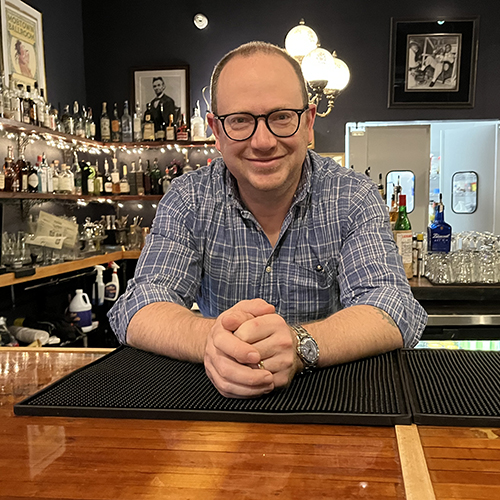Awards matter. For writers, a major award substantially increases the visibility of their work. Yet the most coveted writing award, the Nobel Prize in Literature, is influenced by many factors beyond a writer’s talents — including gender, nationality, native tongue, and more.
Intrigued by the politics of the Nobel Prize, UW professor Eric Ames has created a 200-level course, World Literature and the Nobel Prize. Faculty from departments across the humanities participate as guest speakers, each presenting a Nobel laureate’s work and the factors that led to that writer’s selection.
“The political issues are endless,” says Ames, chair of the Department of Comparative Literature, Cinema & Media, who notes that the gender ratio for honorees is particularly disturbing. Since the Nobel Prize for Literature was introduced in 1901, 90 percent of recipients have been male. “The Nobel Committee is proud of that,” says Ames, “which surprised me until I learned that this ratio is actually better than that of all other Nobel prizes. Change is going to be very, very slow.”

It doesn’t help that Nobel Prize honorees are selected by a governing body whose 18 members — Swedish scholars and writers — hold a lifetime term. “They’re not young,” says Ames, “and very few women have been included.” The committee’s geographic homogeneity may bias its selections as well. Despite the stipulation that no consideration be given to a writer’s nationality, the vast majority of Nobel Prize winners hail from Western Europe and the United States. Only one recipient has been from Africa, and that individual writes in English.
Despite all these caveats — and also because of them — Ames envisioned the Nobel Prize in Literature as a compelling framework for a world literature course. When he reached out to faculty colleagues to participate, more than 30 volunteered. “This is pro bono, so it’s asking a lot,” says Ames, “but faculty understand that it’s an opportunity to introduce students to their department.” Ames selected eight guest lecturers from seven departments, attempting to capture the politics and breadth of the award over more than a century.
Our hope is that, after hearing faculty from across the humanities and sampling a wide range of literatures, students will be hungry for more.
In their two-hour lectures for the 100-student class, the guest speakers touch on several key points: characteristics and stylistic traits of their chosen Nobel Prize writer, the politics of the selection, translation issues, and thoughts on why the writer matters. The selected writers reflect the prize’s 116-year span, from the Bengali writer Rabindranath Tagore, who won in 1913 during a period of European fascination with the East, to American singer-songwriter Bob Dylan, selected in 2016. Students read excerpts of each writer’s work, as well as the recipient’s acceptance speech, and sometimes the Academy’s presentation speech about the honoree’s work.
The course begins with Bob Dylan’s controversial Nobel Prize, in a lecture presented by Ames. “I use Dylan as a way in,” Ames says. “His selection raises all sorts of questions immediately, like what is literature? Can a song be literature? If not, why not? For teaching, those questions are really useful.” At the Nobel Prize awards ceremony, the Academy justified their choice of Dylan by comparing him to Romantic poets and ancient bards, going back to the origins of poetry. “That’s not just a rhetorical move,” says Ames, who notes that Dylan had been nominated for the Nobel Prize since 1997. “It is an interesting perspective.”

Unfortunately Dylan didn’t hear the Academy’s speech, because he declined to attend the event. But Nobel recipients must present a lecture in order to receive their hefty monetary prize, so Dylan provided an audiotape of a talk, which resulted in yet another controversy. “Within hours, people noticed that he had cribbed parts of the talk from the Spark Notes to Moby Dick,” says Ames. “But songwriters crib from each other all the time. It raises other intriguing questions about originality, tradition, and appropriation.” Students grapple with many such questions throughout the course as they read works by T. S. Eliot, Gabriel García Márquez, Svetlana Alexievich, and other Nobel laureates.
Plans are underway to offer the class again next year, led by Naomi Sokoloff, professor of Near Eastern languages & civilization and comparative literature, cinema & media.
“The Nobel Prize has been an effective way to reach a really wide audience and introduce them to the humanities,” Ames says. “Our hope is that, after hearing faculty from across the humanities and sampling a wide range of literatures, students will be hungry for more.”
More Stories

A Love of Classics and Ballroom
Michael Seguin studied Classics at the UW and now owns Baltimore's Mobtown Ballroom. The two interests, he says, are more connected than they might seem.

A Healing Heart Returns
In February, the UW Symphony will perform a symphony that Coast Salish elder Vi Hilbert commissioned years ago to heal the world after the heartbreak of 9/11. The symphony was first performed by the Seattle Symphony in 2006.

Need a break from holiday movies? Try these
For those wanting a break from holiday movies, Cinema & Media Studies faculty and grad students offer suggestions.